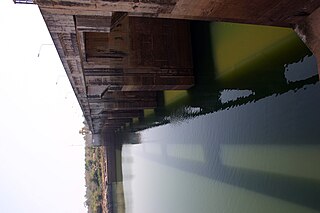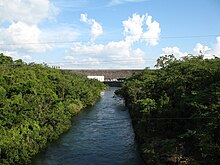
The Pak Mun Dam is a barrage dam and run-of-the-river hydroelectric plant 5.5 km west of the confluence of the Mun and Mekong Rivers in Khong Chiam District, Ubon Ratchathani Province, Thailand. It was constructed by the Electricity Generating Authority of Thailand (EGAT) with support from the World Bank at a total cost of US$240 million, and completed in 1994.

Dams and reservoirs in Laos are the cornerstone of the Lao government's goal of becoming the "battery of Asia".

Vajiralongkorn Dam, also called the Khao Laem Dam (เขื่อนเขาแหลม), is a concrete-faced rock-fill dam (CFRD) in Thong Pha Phum District in Kanchanaburi, Thailand. The dam lies across the Khwae Noi River and was renamed Vajiralongkorn Dam after King Vajiralongkorn on 13 July 2001 when he was crown prince. Vajiralongkorn Dam is Thailand's first CFRD and supplies a 300 MW hydroelectric power station with water. The dam was built and is managed by the Electricity Generating Authority of Thailand (EGAT).
Chulabhorn Dam (เขื่อนจุฬาภรณ์) is a dam in Tambon Thung Lui Lai, Khon San District, Chaiyaphum Province, Thailand. It impounds the Phrom River, a tributary of the Mekong. The dam has diverted the Nam Phrong River. As water leaves its turbines, it empties into the Choen River. The dam is named for Princess Chulabhorn of Thailand.

The estimated hydropower potential of Mekong River Basin about 58,930 Megawatts (MW). As of February 2024, there are an estimated 167 Hydropower Plants (HPPs) in the Mekong, with a combined installed capacity of some 36,376.3 MW. An additional 20 HPPs are currently under construction and at various stages of completion. These have a combined installed capacity of an additional 4,535.5 MW.
The Lower Se San 2 Dam is a hydroelectric dam under development on the Se San River in Stung Treng Province, northeastern Cambodia. The Se San River is a major tributary of the Mekong River. The dam site is located 25 kilometres (16 mi) east of the provincial capital, also named Stung Treng. The first turbine began producing electricity in November 2017. The dam was officially opened on December 18, 2018.
The Stung Treng Dam is a proposed hydroelectric dam on the Mekong River in Stung Treng Province, Cambodia. It would be located on the mainstream of the Lower Mekong River. The project is controversial for several reasons, including its possible impact on the fisheries, as well as other ecological and environmental factors.
Huai Kum Dam, is on the Nam Phrom River in Kaset Sombun District, Chaiyaphum Province, Thailand. It consists of a rockfill dam with clay core and a 1.2 MW semi-underground powerhouse which rises four metres high from the ground and 11 metres beneath the surface. The dam forms a reservoir with a storage capacity of 22 million cubic metres to supply water for the downstream irrigation areas of Chulabhorn Dam in Chaiyaphum Province whereas the power plant provides two million kWh of electric energy per year. The king and the queen accompanied by Princess Maha Chakri Sirindhorn and Princess Chulabhorn presided over the inauguration ceremony on 19 December 1980.
The Lam Takhong Dam is an embankment dam on the Lam Takhong River between Pak Chong District and Sikhio District in Nakhon Ratchasima Province, Thailand. The dam was originally constructed in 1974 for the purposes of irrigation and water supply but after 2002, its water storage also serves as the lower reservoir for the Lam Takhong pumped storage power plant, Thailand's first power plant of that type.
The Nam Pung Dam is a hydroelectric dam on the Phung River in the Phu Phan District of Sakon Nakhon Province, Thailand.

The Ubol Ratana Dam, formerly known as the "Phong Neeb Dam", is a multi-purpose dam in tambon Khok Sung, Ubolratana district, approximately 50 km (31 mi) north of Khon Kaen, Khon Kaen province, Thailand. It was the first hydroelectric power project developed in Thailand's northeastern area of Isan. The dam impounds the Nam Phong, which flows into the Chi River and thence to the Mun River, a tributary of the Mekong River. The dam was given its current name by royal permission in 1966, in honour of princess Ubol Ratana, the eldest child of King Bhumibol Adulyadej.
The Houay Ho is a dam located in Samakkhixay District of Attapeu Province, Laos, 160 km (99 mi) east of Pakse and 30 km (19 mi) northwest of Attapeu. The project is considered the first privately financed joint venture 'build-operate-transfer' (BOT) hydropower project in Laos. It has installed capacity of 152.1 megawatts (204,000 hp), almost all of which is exported to Thailand.
The Duber Khwar Hydropower Plant is located near the town of Pattan in Kohistan, Khyber Pakhtunkhwa, Pakistan on the Duber Khwar River, a right bank tributary of the Indus River. It is approximately 340 km NW from Islamabad, the federal capital of Pakistan.
The Nadarivatu Dam, also known as the Korolevu Dam, is a concrete gravity dam on the upper reaches of the Sigatoka River in Nadarivatu District of Nadroga-Navosa Province, Fiji. The primary purpose of the dam is to generate hydroelectric power in a 41.7 megawatts (55,900 hp) run-of-the-river scheme. The Nadarivatu Hydropower Scheme was first identified in 1977 during a hydropower study. Detailed plans for the project were developed in 2002 and major construction began in 2009. The power station was commissioned on 7 September 2012 but an inauguration ceremony led by Prime Minister Frank Bainimarama was held a week later on 14 September. Funding and loans for the project was provided by several organizations to include the China Development Bank, Fiji Electricity Authority bonds, ADZ Bank. The 40 m (130 ft) tall dam diverts water from the Sigatoka River through a 3,225 metres (10,581 ft) long headrace/penstock tunnel to a power station along the Ba River to the southwest. The power station contains two 20.85 megawatts (27,960 hp) Pelton turbine-generators. The drop in elevation between the reservoir and the power station affords a gross hydraulic head of 335.7 metres (1,101 ft).

The Bihai Power Plant is a hydroelectric power plant in Xiulin Township, Hualien County, Taiwan.
Renewable energy in Thailand is a developing sector that addresses the country’s present high rate of carbon emissions. Several policies, such as the Thirteenth Plan or the Alternative Energy Development Plan, set future goals for increasing the capacity of renewable energy and reduce the reliance of nonrenewable energy. The major sources of renewable energy in Thailand are hydro power, solar power, wind power, and biomass, with biomass currently accounting for the majority of production. Thailand’s growth is hoped to lead to renewable energy cost reduction and increased investment.
Thailand has set targets and policies for the development of its energy sector for 2035, with priority being given to indigenous renewable energy resources, including hydropower.

The Kulekhani Dam is a rock-fill dam on the Kulekhani River near Kulekhani in the Indrasarowar Rural Municipality of Makwanpur District in Bagmati Province, Nepal. The primary purpose of the dam is hydroelectric power generation and it supports the 60 MW Kulekhani I, 32 MW Kulekhani II and 14 MW Kulekhani III Hydropower Stations. Construction began in 1977 and Kulekhani I was commissioned in 1982. Kulekhani II was commissioned in 1986 and a third power station, the 14 MW Kulekhani III was expected to be commissioned in May 2015 but was delayed due to issues with the builder. The US$117.84 million project received funding from the World Bank, Kuwait Fund, UNDP, Overseas Economic Cooperation Fund and OPEC Fund. It is owned by Nepal Electricity Authority.







